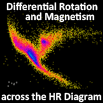Speaker
Aditi Sood
(School of Mathematics and Statistics, University of Sheffield)
Description
A dynamic model of dynamo and rotation is investigated to understand the
observational data of the dependence of the magnetic activities and the differential
rotation \Delta \Omega on the rotation rate \Omega. Specifically, we propose a
minimal seventh order non-linear dynamical system for magnetic fields and
differential rotation \Delta \Omega by parameterizing the generation and
destruction of magnetic fields by \alpha-\Omega effect and magnetic flux loss from
stars and by including quenching of \alpha effect and differential rotation \Delta
\Omega due to Lorentz force. By examining different forms of alpha quenching and
flux loss, we study how the strength and frequency \omega of magnetic fields, and
the differential rotation \Delta \Omega change with the rotation rate \Omega
through dynamo number. In particular, among the three cases with (i)
\alpha-quenching and no flux loss (ii) flux loss and no \alpha-quenching; (iii)
\alpha-quenching and flux loss, our results show that the best agreement with
observations is obtained in the case
(iii) with equal amount of alpha quenching and poloidal and toroidal magnetic flux
losses with quadratic nonlinear dependence on |B|. Specifically, in this case, the
frequency spectrum of magnetic field has a well-localized frequency of the maximum
intensity which scales as \omega \propto \Omega^(0.80), in agreement with observation
of Noyes et al. (1984), while magnetic field and mean differential rotation exhibit
the tendency of saturation for high rotation. Implication of our results in light of
necessary dynamic balance is discussed.
Authors
Aditi Sood
(School of Mathematics and Statistics, University of Sheffield)
Eun-Jin Kim
(School of Mathematics and Statistics, University of Sheffield)

